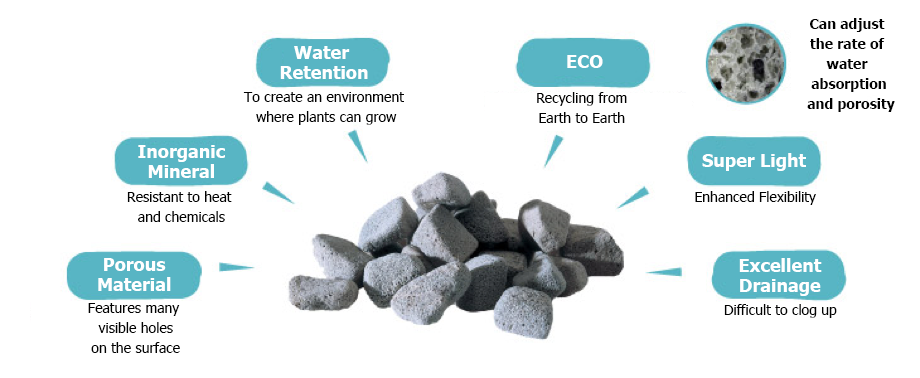
Characteristics of Supersol

Characteristics of Supersol
Soil Restoration
Environmentally friendly and perfect for recycling from earth to earth. In terms of renovation construction, Supersol is the same as surplus soil treatment.
Water Permeability and Retention
Excellent drainage even when compacted. It is excellent at water permeability and retention as well as breathability, facilitating the growth of vegetation.
Incombustible
Because Supersol is made from glass, it is an inorganic material, which in turn make it fire-resistant. It also has a feature that is resistant to chemicals.
Application Capacity
Supersol has numberous application possibilities in the construction field. It may be used in any construction condition, no matter how distorted the terrain is or whether an underground pipe exists. Due to its lightweight, Supersol is easily handled and makes execution possible even under rainy conditions.
* Very light(3~4kN/m3)
* It is easily handled as embankment material and the construction process can be executed under normal procedures.
* No neccesity for a culture period
* It is made of recycled glass bottles and does not elute hazardous substances, safe for the surrounding environment.
* It is an inorganic mineral, thus chemically stable and no corrosion.
Lightweight (Controllable Specific Gravity)
Specific gravity of super sol can be controllable according to the use.
Changing the additive mixture and baking condition, various products with different quality can be made.
| Standard | Specific Gravity in Absolutely Dry Condition | Absorption Rate | Characteristic | Cell Structure | Use |
|---|---|---|---|---|---|
| L1 | 0.3~0.6 | 30% and above | Open-cell-foam-type. Super lightweight material with high water retention. |  |
Greening: Drainage material ・Artificial lightweight soil ・Soil improvement material Horticulture: Improvement material for soil ・Pot bottom stone Agriculture: Soil improved material ・Culvert drainage material |
| L2 | 0.4~0.5 | 30% and below | Closed-cell-foam-type. Super lightweight material with strength. |  |
Civil engineering: Llightweight embankment material ・Retaining wall backfill ・Lightweight mixed soil ・Abutment rear embankment material ・Material for modifying freeway level Livestock: Water quality purification material |
| L3 | 0.5~1.0 | 10% and below | Almost closed pore-type. Lightweight material. |  |
Horticulture: hydroculture material Pet: cat litter |
| L4 | 1.0~1.6 | 5% and below | Closed-cell-foam-type. Material that nearly sinks in water. |  |
Civil engineering: backfill material for the rear of earthquake-resistant wharf ・Less than HW level lightweight embankment material Livestock: Water quality purification material ・Farming pond filter material |
Components Table
Compound |
Name |
Content |
|---|---|---|
SiO2 |
Silicon Dioxide |
73.5% |
CaO |
Calcium Oxide |
12.1% |
Na2O |
Sodium Oxide |
10.5% |
Al2O3 |
Aluminium Oxide |
1.57% |
K2O |
Potassium Oxide |
0.98% |
MgO |
Magnesium Oxide |
0.42% |
Characteristic of Supersol as a Lightweight Embankment Material
Individual Supersol |
|
|---|---|
Specific Gravity (Dry state) |
0.4~0.5 |
Particle Diameter Range |
2~75mm |
Moisture Content |
0% |
Uniaxial Compressive Strength |
30~40kgtflcm2 |
Harmful Substance |
None |
When Compacted |
|
|---|---|
Density |
0.3~0.4t/m2 |
Triaxial Compressive Strength |
φ=30°and above |
CBR Value |
17.70% |
Coefficient of Water Permeability |
3x10-2~1x100cm/s |
Design Constant
Dry Density (t/m3) (Metric) |
Design Constant |
Number of Compaction for a 30cm Leveling Thickness (time/layer) | ||||
|---|---|---|---|---|---|---|
| Wet Density (t/m3) | Adhesive Force (kN/m2) | Angle of Internal Friction (degree) | Allowable Bearing Capacity (kN/m2) | 10-Ton Class Wetland Bulldozer | 1-Ton Class Vibratory Roller | |
| 0.25 | 0.4 | 0 | 25 | 39 | 0 | 0 |
| 0.3 | 0.45 | 30 | 98 | 2 | 4 | |
| 0.35 | 0.055 | 137 | 4 | 8 | ||
| 0.4 | 0.6 | 176 | 8 | - | ||
Information:Civil engineering materials technology and technology assessment and certification report
Type of Lightweight Embankments
Classification |
Lightweight Embanment Material |
Wet Density (t/m3) |
Feature |
|
|---|---|---|---|---|
| Methods that use lightweight materials | Artificial Materials | EPS | 0.01~0.03 | Ultra-lightweight, self-standing |
| Urethane Foam | 0.03 Grade | Ultra-lightweight, fluidity | ||
| Natural Materials | Water Granulation Slag | 1.2~1.35 | Ironworks by-product | |
| Coal Ash | 1.1~1.5 | Thermal power plant by-product | ||
| Supersol | 0.4~0.6 | Manufactured from waste glass bottles | ||
| Volcanic Ash Soil | 1.2~1.4 | Inexpensive | ||
| Method from weight reduction of soil | Foamed Mixture Lightweight Soil Method | FCB (Foamed Cement Banking) | 0.5~1.2 | Fluidity, Adjustable density Adjustable |
| Foamed Beads Mixed Lightweight Soil | SLS (Stabilized Light Soil) | 0.9~1.3 | Adjustable density, characteristic close to soil | |
